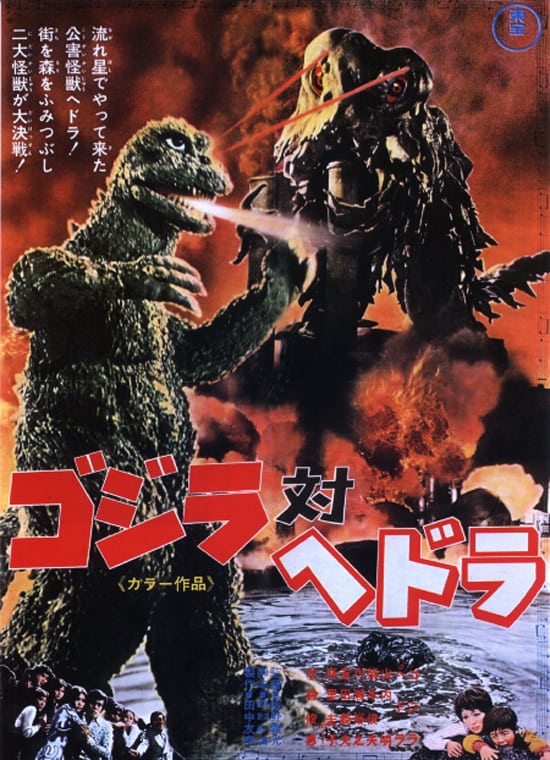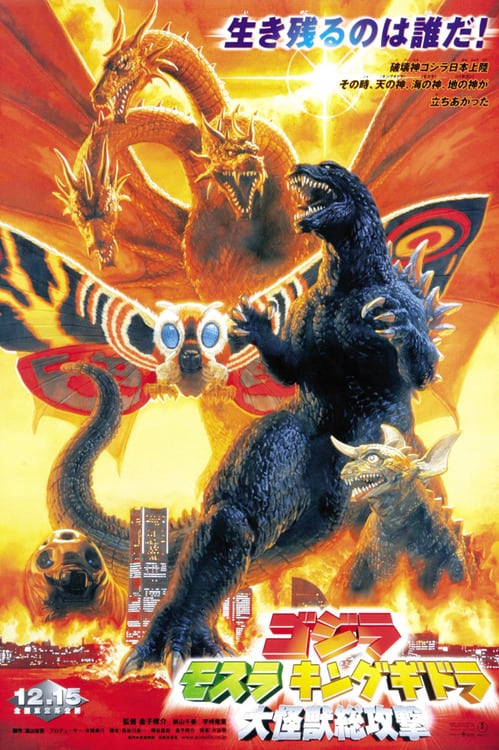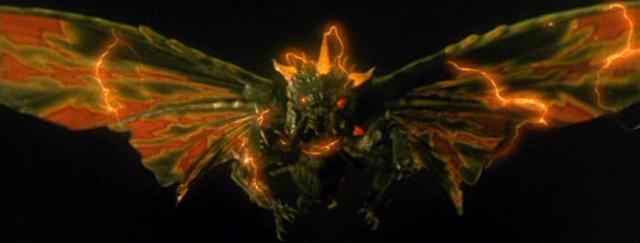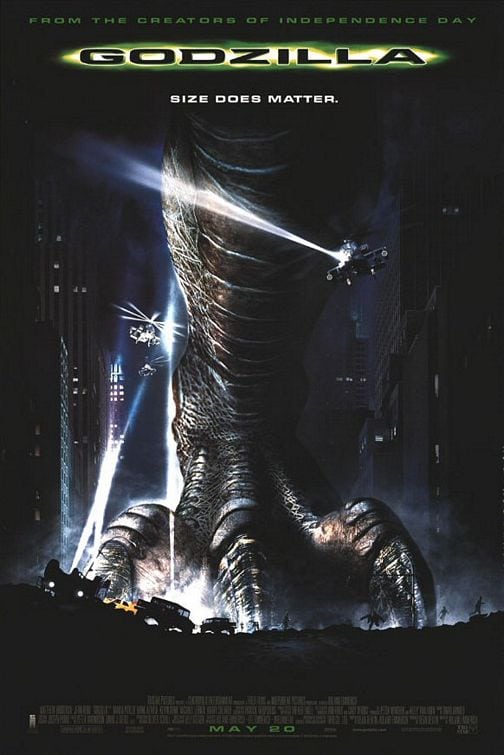Godzilla Vs Hedorah (1971)
Directed by: Yoshimitsu Banno
Written by: Takeshi Kimura
Starring: Akira Yamaguchi, Hiroyuki Kawase, Toshie Kimura, Toshio Shiba
HCF REWIND NO.139. GODZILLA VS HEDORAH AKA GOJIRA TAI HEDORA, GODZILLA VS THE SMOG MONSTER [Japan 1969]
AVAILABLE ON DVD
RUNNING TIME: 85 min
FEATURED MONSTERS: GODZILLA, MINILLA, HEDORAH
REVIEWED BY: Dr Lenera, Official HCF Critic
A fisherman brings marine biologist Dr. Turo Yano something interesting that he caught that morning, something that looks like a tadpole but is nearly a foot long and was caught in salt water where no amphibian could survive. On the news, two oil tankers which have collided are forced apart by a similar but much larger creature. Turo goes for an investigative dive with his son Ken where the fisherman was, and comes out with a side of his face burnt by some kind of sulphuric acid secretion. Intuitively making the connection between the monsters and the intense industrial pollution of the waters in which they apparently live, Ken dreams that Godzilla will come to save the day, but it seems that this toxic new species, called Hedorah, can metamorphosise…..
Godzilla Vs Hedorah was the first Godzilla film I ever saw. It was showing, in its US version called Godzilla Vs The Smog Monster, in a late night season of films entitled The Worst Of Hollywood [though not all the films were Hollywood ones] presented by a guy called Michael Medved who had written similar books. As I often did when I was young, I sneaked downstairs and watched it, and thought it was awesome if a little weird. Indeed, it’s definitely the oddest Godzilla film, and in some ways the most dated, in that you can tell within a couple of minutes when it was made. It’s directed in a very ‘far-out’, almost psychedelic fashion, incorporating elements as disparate as science lessons, animated segments and acid-induced hallucinations! It’s a Godzilla movie on drugs, a film in which Godzilla flies. It’s also a bit of a mess, and can’t seem to decide on a consistent tone or what audience to aim at. It’s not really a success, and I’m glad there weren’t other Godzilla films made like it, but I’m very glad this bizarre entry exists in the form it does.
The ‘70’s were a bad time for the Japanese film-industry. The increasing popularity of TV, including a plethora of fantastical shows featuring giant robots, monsters and aliens, plus a terrible recession meant that cinema attendance was rapidly declining, and in turn studios rapidly cut budgets and crew. After the middling Space Amoeba, most of the people involved in Toho’s Golden Age, both in front of and behind the camera, departed before they could be laid off. Even the great Ishiro Honda went into semi-retirement. Nonetheless, Toho wanted the Godzilla series to continue. Takeshi Kimura was an experienced script writer for these films, but first-time director Yoshimitsu Banno was given free reign with the new movie because producer Tomoyuki Tanaka was in hospital. When Tanaka saw the almost-finished film, he hated it, and, according to some sources, asked Honda to intervene, though it’d hard to tell what Honda did. In any case, it seems that Banno and Kimura were at odds considering the film’s wildly inconsistent tone. Though it did reasonable box office, Banno’s plans for a sequel [which the ending hints at] also attacking pollution, which first involved a mutant starfish monster, then another Hedorah but set in Africa, were nixed. The uncut AIP US release was the last Godzilla film that was dubbed specifically for the States.
The aim with Godzilla Vs Hedorah seems initially to take the series back to the horror and serious intent of Godzilla way back in 1954. While that film constantly paraded its anti-nuclear message, this one doesn’t stop showing how awful pollution is. It opens with really ugly shots of a polluted bay, among them some striking images such as a broken doll looking like a human corpse, and repeats them, and similar visuals, throughout. The early diving sequence has a dark tone and you odn’t tend to see people’s faces burnt in these movies. Hedorah, though in execution not that convincing in any of his four forms, is conceptually at least a truly horrific monster with an arsenal of nasty weapons including not just a red ray from his eyes but bodily secretion, acid muck emitting from just under his eyes, and horrendous fart fumes. You actually see people killed, and some of them even turn into skeletons. There’s a cat stuck in slime and even a brief shot of a baby trapped in mud. All this would be fine if the film maintained this tone, but it also decides every now and again that it has to appeal to children too, so you also get a small boy hero who early on is seen playing with Godzilla toys, Godzilla flying, and lots and lots of monster footage. But then there are also scenes like a guy tripping on acid in a psychedelic nightclub and imagining everyone has a fish for a head. Sometimes the film seems to be aimed at young adults who are environmentally-aware but also like to party hard, but then it also attacks such people as fools [in fact everyone except Turo and his son are fools in this picture]. Hedorah is threatening to destroy Japan, so what do the local ‘hip kids’ do? Throw a party near Mt. Fuji.
Though there are human protagonists who seem to be important to the story, the monsters really do take centre stage here, so much so that you forget about the scientist trying to solve the riddle of this strange new species and the boy who seems to have some kind of telepathic connection to Godzilla. He first shows up in his dreams in an impressively photographed night-time scene where he blasts the polluted bay with his breath, then appears soon after to battle Hedorah and follow him around on his path of destruction. There’s an aimless feel to much of this and the several battles are none too exciting, despite Hedorah being a truly powerful opponent. The final confrontation is very slow-paced and could do with tightening up considerably. This is a rare Godzilla film where I almost lose interest during the monster fighting. Still, Godzilla flies. He stretches out his arms, breaths at the ground and this somehow makes him float into the air while he holds his tail for steering. It’s one of the ultimate goofy Godzilla moments, enhanced by a patriotic-sounding march, and I love it, but it detracts from the initial serious intent of the film it’s in.
Godzilla looks much the same as before except for a rather long neck. Haruo Nakajima gives his most physical performance as Godzilla, constantly waving his arms around, while Hedorah is played by Ken Satsuma, who would later take over the role of Godzilla. Hedorah rarely convinces but is well worked out in terms of having four evolutionary stages. The low budget really shows though in having most of Hedorah’s destruction occur off-screen; we mostly just hear about it. New special effects head Teruyoshi Nakano does give us some great pyrotechnics when Hedorah attacks an industrial area. This is really a director’s film though, with Banno constantly trying to do interesting things. Some of them don’t work, but you certainly can’t say the direction is dull. TV screens showing images multiply and then turn into coloured squares. Cartoons explain pollution and Hedorah so five year olds can understand. In probably the best bit, the big party begins where Yukio, the main teenage protagonist, first plays a very cool solo on his guitar, as old men – who may be ghosts, may not be – watch from the surrounding bushes. Then suddenly his guitar becomes electric, though there’s no source of power, everyone else joins in, and it turns into a massive rave-up. The scene makes no sense but is quite exhilarating. The fact that Banno and Nakano fail to make the numerous monster fights exciting though is a big problem in a Godzilla film.
The cast are adequate, with Hiroyuki Kawase quite a likeable little boy. The score by Richiro Manabe is very experimental. Manabe often resorts to having the instruments seemingly improvising against a simple riff in the lower registers slowly going higher, but things like a Jew’s harp going “boing, boing, boing” for Godzilla’s first appearance just seem appropriate for this film. Godzilla’s horn fanfare sticks in the mind, and the several-times-repeated title song Bring Back Nature, sung by the movie’s female lead Keiko Mari, has a very catchy tune. It was actually re-recorded in English as Save The Earth for the US release, and it’s a great shame that the current R1 DVD just features Toho’s international version which only has the song in Japanese. As for the film, it fails as much as it succeeds, but it’s quite unique, almost to the point where words can’t really convey the experience of watching it. Godzilla Vs Hedorah may not be considered ‘good’, but it’s certainly interesting…..whether enhanced by mind-altering substances or not. And Godzilla flies.
Rating: 

















Be the first to comment